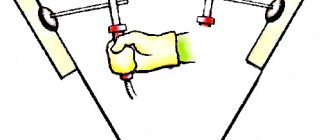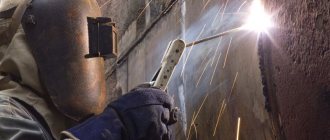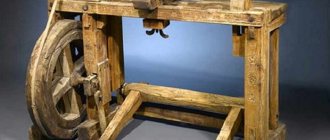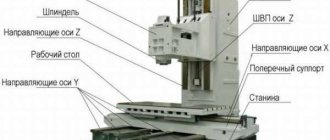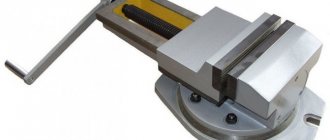Computer numerical control machines are designed to minimize human participation in production processes. They cope with the task perfectly - there are almost no enterprise risks associated with the human factor, and the result of the operation of CNC units is highly accurate.
You can build a successful business by choosing a 3D CNC milling machine for wood or metal to suit the needs of the enterprise. What characteristics should the unit have? Are the machines worth their stated prices? Which characteristics are important and which are secondary? The features of choosing CNC milling machines are discussed in the material below.
Multicut-3000 machine
Comparison criteria
The technological equipment presented on the market is improved and refined every year.
Some milling units become obsolete after 5-7 years of service. However, among them there are decent machines; it is only important to identify them.
There are several universal criteria by which a CNC milling machine is selected. These are:
- design features of the unit;
- purpose (scope of use) and functionality;
- processed materials;
- price.
Let's look at each of them separately.
Spindle
The spindle is the heart of the milling machine. It provides both speed and quality of cutting, so when choosing a machine you should pay close attention to it. From the very beginning, you need to find out the manufacturer, evaluate its credibility and whether practitioners recommend it.
Look at the type of spindle, they come in air and water cooling.
Air-cooled spindles are easier to use, but are noisier and have one bad feature, namely a tendency to clog the cooling impeller with cutting products (dust and chips) and, accordingly, overheat, which greatly reduces service life.
In our opinion, water-cooled spindles are more universal; they are protected from clogging and can work with any materials. With a properly configured cooling system, overheating of the water-cooled spindle is eliminated, and therefore durability is increased.
Well, it’s also important to look at the spindle power. The higher it is, the more productive the machine will be and will make more samples in one pass. This greatly impacts performance.
Design specifics
The classification has several subcategories:
- number of spindles (one- and two-spindle models with different performance);
- installation location (floor/table);
- number of axes of movement of the router (one-, two-, four-axis);
- direction of movement of the router (horizontal, vertical, universal).
Having examined CNC milling machines in more detail, it is easy to notice that their individual elements differ. For example, a spindle is an electric motor that feeds a collet with a clamped cutter and affects the processing accuracy.
The main characteristic of spindles is power, and the design feature is the presence or absence of a cooling system. Power determines the scope of use of a particular node. For example, spindles at 0.8; 1.5; 2.2 kW is found in compact units for 3D engraving in domestic conditions. If a milling cutter is used for cutting chipboard or MDF at an enterprise, devices with a power of 3 kW or more are used.
The cooling system is found on CNC milling machines, in which the spindle rotates at high speed. Its presence reduces the risk of equipment overheating and failure. Machines can be liquid or air cooled; the former are less powerful.
The work table may also differ between machines. In small-sized ones it is movable; for the rest, it is static, moving only along the vertical axis.
CNC machine
Tables based on the method of fastening workpieces are divided into vacuum and equipped with T-shaped slots. In the first, the parts are fixed using a vacuum pump. The design is supplemented with a sealing cord, which cuts off excess sections of the workpiece.
T-slots are found on small wood routers. In terms of the strength of fastening parts, they are superior to a vacuum pump.
In order not to delve into the other design features of milling units, let’s consider them using the example of equipment from the Multicut company (Novosibirsk). The units are presented in the following series:
- 500. Tabletop machines for small production. Equipped with a plastic table 600x900 mm mounted on a cast iron frame. They are in demand among companies selling souvenirs, furniture, and advertising structures.
- 3000. Medium-sized machines for 3D cutting of sheet materials. Table sizes - up to 2100x4050 mm; there are movable portals with a carriage stroke of up to 250 mm.
- 5000. The series machines are equipped with an automatic cutting tool replacement system. There are devices for rotating workpieces (when processing cylindrical parts). They can use up to 8 cutters of different configurations in one processing cycle.
CNC machine Multicut-5000
bed
The most important component that you should pay attention to when choosing a milling machine, if the bed is not strong, then you will not get quality work and quality products. It is bad if the machine bed is assembled from various elements by fastening with screw connections; all this will become loose during operation due to vibrations of the machine and make the structure flimsy and completely inaccurate.
The frame must be entirely welded and it would be better from profiled iron several millimeters thick, ideally cast.
When choosing a machine, check how much the machine weighs without the portal part in order to roughly estimate what kind of iron the bed is made of.
Another sign of the quality of the frame is the thermal tempering of the structure. This is when, after welding, the entire frame is heated in a furnace to several hundred degrees Celsius, kept for one hour, and then allowed to cool under natural conditions.
After this, the seats for the transmission racks and guides are milled. Thermal tempering ensures that the frame will not move during operation and, in general, has a very good effect on the accuracy of mechanics.
Scope of use
Numerical control machines are used in woodworking. They either aesthetically design small products or produce large parts. Also possible:
- performing figure cutting;
- drawing reliefs of any complexity;
- production of components for cabinet furniture.
CNC machines are no less important in metalworking. Applying engraving, relief images on workpieces, and grinding are sometimes difficult even for an experienced worker. The introduction of equipment optimized the production process.
Mechanical engineering is another industry where milling machines have a place. Here with their help:
- produce machine parts, the dimensional accuracy of which is subject to high demands;
- process power elements, stiffeners, body kit elements;
- create carbon linings and aluminum blanks.
A CNC milling machine in jewelry processes most precious metals. Tabletop units are used here. High-precision engraving on coins, souvenirs, rings and other jewelry is the task of the devices.
The equipment is gradually being introduced into the construction industry. The machines create injection molds and models of structures or vehicles.
How to choose a CNC milling machine?
CNC milling machines are rightfully considered the best equipment for large companies specializing in the production of furniture or carpentry.
It will be difficult to find at least one enterprise in the woodworking industry that does not use milling centers. Choosing a high-quality machine is a very responsible matter, since there is a risk of purchasing equipment that will not suit the needs of your enterprise. We have put together some useful tips for you to make it easier to choose the right model.
Processed materials
Wood processing devices have average power (1-1.5 kW) and a reinforced design. Since there is a risk of the cutter jamming during operation, the machines are equipped with a device for supplying coolant to the contact point. This is water or machine oil. The units are used for the manufacture of furniture legs, slotted decor, picture and photo frames, facades, and figured consoles.
Metal cutting machines look and operate somewhat differently. Their features:
- more complicated design compared to wood routers;
- high price;
- lack of a cutter cooling function in a number of models (since the risk of fire due to friction of the cutter on the workpiece is minimal);
- Possibility of equipping with an industrial vacuum cleaner socket (for removing chips).
Automatic waste collection is almost never carried out, since contact with skin, eyes or respiratory organs will cause harm to health. Typically the task is performed manually by the operator.
In machines for processing plastic and plexiglass, cutters with a diamond or corundum working surface are used. The coating can be sprayed or all-sintered. Diamond chips are baked on the surface of the router at high temperature, resulting in a strong and durable connection.
The liquid must be supplied to the area of contact with plastic/glass. Otherwise, waste getting under the cutter can lead to damage to the entire workpiece (due to the plasticity of the material).
Units of the 3000, 3200, 4000, 4400, 5000 series are suitable for processing PVC, acrylic glass, polycarbonate, and fiberglass.
Multicut-4000 machine
Characteristics of wood processing machines
One of the main points you need to know when purchasing or assembling a machine is that for greatest efficiency the spindle of the machine must be positioned horizontally. The best option would be to attach the cutter vertically to the shaft. For a wood milling machine, this is quite important, since it becomes possible to adjust the height of the actuating tool. The part to be processed is fixed on a horizontal plane, and its position is limited by a stop and a guide.
This makes it possible to effectively work on workpieces of all sizes and with batches of different sizes. The optimal choice is a horizontal wood milling machine. Thanks to it, you can process wood with your own hands in the most convenient and efficient way. Read about making your own milling machine in this article.
One of the main characteristics is power. It depends on the installed engine. A minimum power of 400 W should be enough to perform small-scale work, both fine and rough. If you plan to use the device professionally, then it is advisable to choose a machine with a power of 1.4 kW or more. It can process impressive volumes of wood, plastic and some soft alloys.
Cost of installations
CNC milling machines are divided into three categories:
- Budget models. These are, for example, mini-machines for small businesses or home workshops. Their power is small, as is the working area, and the positioning accuracy is clearly worse than that of advanced models. The equipment performs a limited number of operations and costs no more than 150 thousand rubles. Suitable for milling wooden workpieces and individual metals.
- Average price category. This includes models no more expensive than 500,000 rubles. Most have a liquid or air cooling system. The level of automation and power allows for linear production of products with certain parameters. CNC milling machines are suitable for decorative finishing of surfaces and production of three-dimensional structures.
- Expensive machines. The price tag can exceed 1.5 million rubles. Here the buyer pays for high-precision processing of all types of materials and the possibility of 3D modeling.
Types of routers for home
Its main purpose is to perform various types of wood processing, such as roughing, finishing and semi-finishing (for example: manufacturing simple parts, artistic cutting). To perform these works, you will need an actuating tool - various cutters, including:
- disk;
- corner;
- end;
- shaped;
- cylindrical;
- terminal
The variety of working tools is quite large, so everyone can use a home router in many types of processing of different materials.
Useful tips for choosing machines
To avoid making a mistake when choosing an expensive installation, use the recommendations of experts:
- if metal processing is not intended, a powerful machine is of no use;
- when selecting sizes, focus not only on the dimensions of the workpieces, but also on the room for the machine - dimensions, access to the unit from the sides, the ability of the interfloor ceilings to support the weight of the machine;
- productivity is not synonymous with efficiency; powerful models consume a lot of energy.
Before purchasing, it is advisable to study not only the characteristics of the machines, but also obtain the information of interest from an expert. For example, the device's ability to perform specific tasks or whether it has specific options.
The range of milling machines with numerical control is large, and there is suitable equipment for any task. Contact a MULTICUT representative if you are considering units of this brand for purchase.
What coolant should I use?
When processing workpieces made of various types of metals, it is worth selecting and purchasing the appropriate cutting fluid. Our specialists will help you with this.
Detailed information about coolant for lathes is available here. If you have any questions, you can always request a free consultation.
Our range includes lubricants produced in Germany at the Zeller+Gmelin plant. The plant has its own laboratory and development center and has been supplying the largest metalworking industries around the world for more than 100 years.
Auto tool change
Before purchasing equipment, it makes sense to decide on the nature of the work and the tools needed to perform it. For carrying out the same type of processing with infrequent replacement, models with manual change are quite suitable, but if you need to regularly select different tools, it would be more advisable to purchase a machine with an automatic change or a semi-automatic mechanism. This will not only reduce the time it takes to complete the work, but also increase accuracy.
Workpiece dimensions
Experienced specialists know that in order to perform the job efficiently, it is necessary to go through the entire surface being processed at once, otherwise precious time will be wasted on readjustment and a possible decrease in accuracy. To prevent this from happening, you need to determine the maximum dimensions of the workpieces used and, based on this, select a model with a suitable working field.
It is also worth taking into account the length of the spindle stroke along the Z axis, because the thickness of the workpiece that the milling machine can process depends on it. To obtain an accurate value, it is necessary to subtract the length of the tool and chuck (ISO30 or collet) from the stroke length. The final result will be the maximum allowable thickness of the workpiece.
